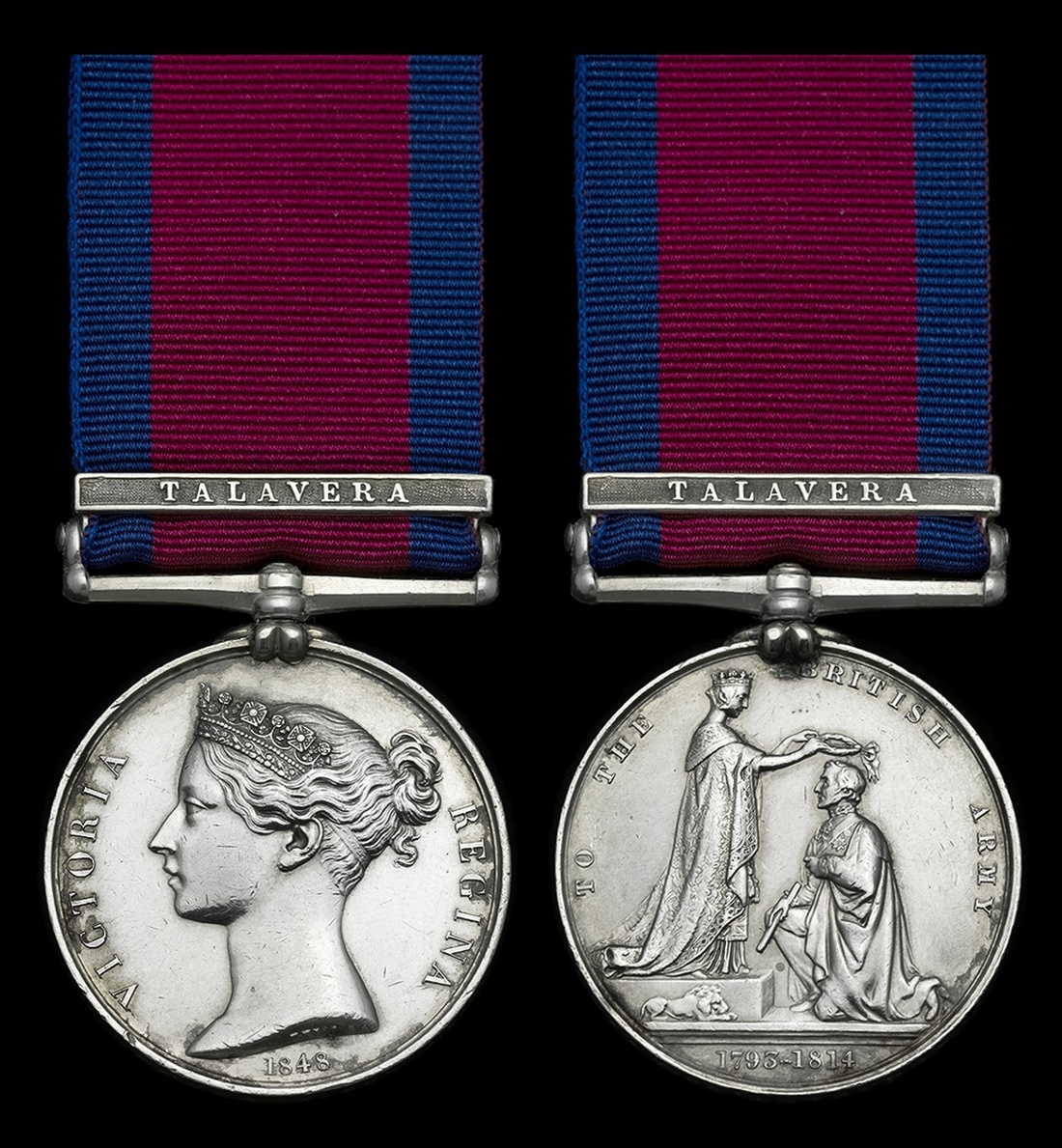
Auction: 24003 - Orders, Decorations and Medals
Lot: 15
The Military General Service Medal awarded to Sergeant J. Gould of the 23rd Light Dragoons, who took part in the disastrous charge into a dry watercourse at the Battle of Talavera, and who was also later likely present at the infamous Peterloo Massacre as a member of the 15th Hussars
Military General Service 1794-1814, 1 clasp, Talavera (John Gould, Sergeant, 23rd Light Dragoons.), good very fine
'…men and horses stumbled, staggered, half leaped, fell in heaps by the hundred to either lie there wrecked and broken, men dragged by their surviving horses and some even to gain the far bank where Lieutenant-Colonel Elley, full of bravery rallied a reasonable number, so much so that he recklessly called on them to complete the charge.' A description of the devastating aftermath of the 23rd's charge at Talavera, in which the regiment plunged into an unseen ravine. Ray Foster's "Notes on Wellington's Cavalry in the Peninsula: 23rd Light Dragoons", refers.
John Gould was born near Barnstable, Devon in July 1788 and enlisted with the 23rd Light Dragoons at Weymouth in 1807 as an 18-year-old labourer. The unit joined Major-General George Anson's Brigade with the 1st Hussars KGL upon disembarking at Lisbon in June 1809 and swiftly saw action the following month at the Battle of Talavera. The final day of the battle, they were ordered to stop French General Ruffin's division from advancing on the British left flank, and while leading a cavalry charge in the execution of those orders, the Regiment plunged into a dry watercourse that had been hidden from view. The above account from Ray Foster gives some indication of the subsequent catastrophe. Those remaining soldiers reformed and recklessly recharged the French, in the end suffering 45% casualties with many more wounded and taken prisoner. The future Duke of Wellington, Arthur Wellesley, noted after the battle that 'although the 23rd Dragoons suffered considerable loss, the charge had the effect of preventing the execution of that part of the plan'. It is also worthy to note that the charge represented the last occasion on which a British cavalry Regiment carried its colours into battle. The depleted unit returned home in December 1809 and in the subsequent years Gould married, was promoted to Corporal and later to Sergeant, and was discharged on 31 October 1817 upon the reduction of the Regiment. The following day, Gould re-enlisted as a Private with the 15th Hussars at Weymouth.
The infamous Peterloo Massacre occurred at St. Peter's Field in Manchester on 16 August 1819, at that time Gould was a Corporal with the 15th Hussars and was stationed in Manchester. While there is no documentation of his presence at Peterloo, it may be reasonably assumed that Gould would have taken part in the event alongside the rest of his Regiment. The massacre was sparked when the Manchester and Salford Yeomanry attempted to make arrests at a mass meeting of the Manchester Reformers, which spiralled out of control into violence and bloodshed. The 15th Hussars were summoned to disperse the crowd and restore order, but instead formed themselves into a line and charged the crowd, resulting in eighteen deaths and hundreds wounded by the end of the day. The following is an eyewitness account of the charge by Samuel Bamford, taken from his Passages in the Life of a Radical:
'On the cavalry drawing up they were received with a shout of goodwill, as I understood it. They shouted again, waving their sabres over their heads; and then, slackening rein, and striking spur into their steeds, they dashed forward and began cutting the people...The cavalry were in confusion: they evidently could not, with all the weight of man and horse, penetrate that compact mass of human beings and their sabres were plied to hew a way through naked held-up hands and defenceless heads; and then chopped limbs and wound-gaping skulls were seen; and groans and cries were mingled with the din of that horrid confusion.'
Gould became Hospital Sergeant in 1824, a position which he held until being discharged on 12 June 1839 due to 'Declining strength from long zealous service as Hospital Sergeant… a very good and efficient soldier and perfectly trustworthy and sober'. He was 52 years of age and had served 32 years and 55 days. Gould, as a widower, married Betsey Clarke in 1839 at St. George the Martyr in Holborn. Census reports reveal he spent the last decades of his life in Leeds, where he died on 19 June 1864; sold together with copied research.
Subject to 20% VAT on Buyer’s Premium. For more information please view Terms and Conditions for Buyers.
Sold for
£1,300
Starting price
£600




